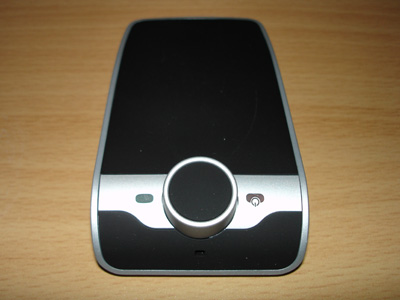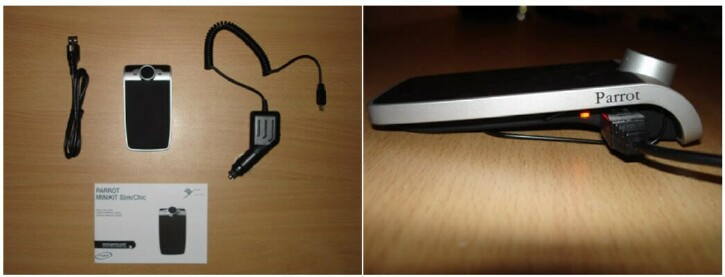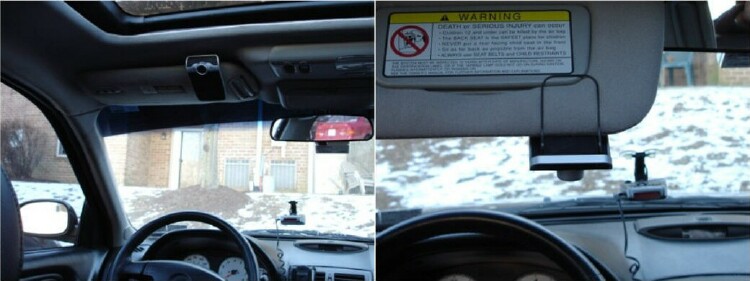User Opinions
|
||||||||||
|
|
|
| Mon Feb 9, 2009 - 5:07 AM EST - By Justin DeJarnette | |
|
|
|
|
|||||||||||

The Parrot MINIKIT Slim is the fourth voice-activated Bluetooth hands-free device that I have owned and/or reviewed, and I am astonished as to how much these things improve with each device I try. To establish a point of reference, I'll give you a quick rundown of each device I have used and how the voice-activation integration has progressed:
The first voice-activated device I used was the mVox MV900, which was a nice speakerphone, but the voice activation was pathetic to the point of being unusable. The phone would recognize up to 12 numbers, but to program the device, I had to literally read all of the numbers into the speakerphone and hope the thing would recognize what I was saying, which it almost never got right. I was also expected to remember that "speed dial 4" was for my girlfriend and that "speed dial" 5 was for my grandmother. You really don't want to mess those up and call your grandmother at 1 o'clock in the morning to make sure it's cool if you stop by after leaving the bar library. The coolest thing about this speakerphone was the caller ID feature, which would read off the number of the incoming caller to you, so if you were lucky enough to recognize the number you could decide on whether or not you want to take the call.
Next came the BlueAnt V1, the "World's First (and still only, I believe) Voice Controlled Headset" that I reviewed for TreoCentral a few months ago. The V1 is a great device and is still my preferred Bluetooth headset. The V1 basically uses the speed dial settings on your phone to achieve voice activation, and does so very well. You can tell the V1 to call "home", "favorite" or even "GOOG-411" to dial numbers for you, and it also reads off incoming caller ID numbers to you. For a headset, this was revolutionary.
About a month later I reviewed the Parrot MINIKIT speakerphone, which used Bluetooth to receive contact information from your phone. With the MINIKIT, I had sent to send each individual contact to the MINIKIT via Bluetooth and then speak the contact's name into the device 2 or 3 times to attach a voice tag. Once programmed, the MINIKIT worked very well. The voice recognition is tremendous, and it would read the names of the contacts you had pre-programmed into the phone when they called you in your own voice, no less.
I thought the MINIKIT's voice activation implementation was about as good as it could get. Let's just say that I was waaaaay wrong...
When I saw the MINIKIT Slim (hereafter referred to as "the Slim") advertised in the TreoCentral store, I figured it was just a slimmed-down version of the MINIKIT. I mean, it looks somewhat similar: there's the same 2-button interface (one red and one green, like on just about every phone out there nowadays) and a nice volume knob for tactile volume adjustment and menu selection. There is a miniUSB charging port and a charging light indicator to let you know when the device is charging. The Slim comes packaged with a miniUSB car charged and a miniUSB-to-USB cable for charging the device via USB port on your computer.

So by the initial looks of the device, the Slim is just a smaller, thinner, lighter MINIKIT. But then when you look a little closer you'll notice that there are some pretty significant design differences other than the more obvious aesthetic ones. For one, there is no dedicated power button on the Slim, which is just fine with me. Just hold the red button down for a couple seconds (like on a Centro or a PalmOS Treo) to turn the speakerphone on or off. You'll also notice that there is no traditional "speaker" on the Slim, which uses a vibrating panel instead. According to the Parrot website, the vibrating panel is "connected to the audio circuit and vibrates to reproduce natural, open sound." Whatever. All I know is that it definitely makes for a much thinner device, and thin is certainly what's in nowadays.

The visor clip on the back of the Slim is also very thin. The clip does a good job of holding the device in place, but it's made of a very thin and pliable metal which may become a problem over time.

One slight annoyance I found with the Slim is that there is no "power on" indicator. There is no way to tell whether or not the device is turned on by looking at it. Some people, however, will actually like this feature, as I have heard a lot of people complain about blinking blue lights and similar indicators on Bluetooth devices. This really doesn't bother me much either way, as you can just hit the green button and if the device is powered on the Slim will ask who you want to call.
Where the Slim really differentiates itself from the original MINIKIT is with its highly advanced contact/voice recognition setup. The MINIKIT requires you to send each individual contact from your phone to the speakerphone one-at-a-time, recording voice tags for each as you go. This can be rather cumbersome. The Slim receives all of your contacts from your phone each time you connect. That's right, all of your contacts (up to 1,000, that is, and if you have more than that, well, aren't you popular?), and you don't have to record voice tags for any of them. The Slim employs incredible text-to-speech synthesis of all of the contacts in your phone, and combines that text-to-speech with excellent voice recognition. To make a long story short, the Slim recognizes your voice and matches your words with your contacts quickly and easily, and with amazing results. I have about 150 or so contacts in my phone, and I have found it difficult to fool the Slim. As long as you speak with some degree of clarity and without a ridiculous amount of background noise, the Slim is spot-on.
Press the green button and the Slim will ask, in its sweet-sounding-yet-SAM-like English accent, "Who do you want to call?" Say "Catherine Hall" and the Slim will repeat the name and will ask which of the contact's numbers (Home, Work, Cell Phone) you want to call, if there are several for the contact. (That's right, the Slim isn't restricted to 1,000 phone numbers, the restriction is to 1,000 contacts. A single contact can contain several phone numbers.) And the device isn't very particular to how you issue the commands: say "Catherine Hall" or "Call Catherine's cell phone," or "Catherine at work" and the Slim will know what you're getting at. The voice recognition logic is top-notch, to say the least.
The Slim also incorporates most, if not all of the little nuances that were used by its other predecessors. When a call comes in, the Slim will match the incoming number with the contact in its memory (if the number is from one of your stored contacts, of course), and use the text-to-speech functionality to announce the name of the incoming caller.
And there is another huge improvement over the MINIKIT that could easily go unnoticed, which involves updating the programmed contacts. The MINIKIT didn't provide any way for you to update a contact; if you changed a number of a contact in your phone, the MINIKIT would never know, as the contact information was stored in the device. There was no way to delete or edit a previously-programmed contact. In fact, the only way to update any of your contacts was to erase all of them from the device and send them back, which also required you to re-record all of the voice tags. Although, realistically speaking, there probably aren't all that many times when somebody you know will actually change a phone number, this was a major omission that I didn't immediately catch when I reviewed the MINIKIT. The Slim totally alleviates this problem, as each time you connect the speakerphone with your cell phone, the Slim automatically synchronizes its internal phone book with the contact list in your cell phone. And don't worry: the process takes less than 30 seconds to update my contact list of about 150 names. This is huge, as you never have to worry about updating any of the contacts on the Slim. Just go through the normal process of editing your contact list on your phone and they will automatically update on the Slim when you connect to it.
The Slim adds some fantastic new features, but it also delivers on the fundamentals: connectivity and sound quality. The Slim connects with the phone quickly and reliably, whereas many of the Bluetooth devices I've used have not been as dependable. I think this is due to the fact that the Slim uses Bluetooth 2.0 and the MINIKIT has Bluetooth 1.2. (It seems that all of my Bluetooth 2.0 devices, including the BlueAnt V1, the BlueAnt M1, etc. connect far more quickly and reliably than the Bluetooth 1.1 and 1.2 devices I own, but I haven't really had the time to put this theory to test.) The whole connectivity thing is crucial, especially when you're in the car and you need to make or receive a call.
The Slim also provides superior sound quality. The vibrating panel speaker setup does an excellent job of reproducing the incoming caller's voice. There is almost no difference between the speaker on the MINIKIT and the vibrating panel on the Slim. In fact, at the higher volumes that are often necessary in the car, the Slim's vibrating panel sounds a lot better than the traditional speakers found on most speakerphones.
The omnidirectional microphone picks up your voice very well, whether facing out towards the driver or if the Slim is attached to the rear of your visor, with the microphone facing the windshield. Most of the people I talked to couldn't even tell I was on a speakerphone.
The MINIKIT Slim is quite simply the best Bluetooth speakerphone I have used. The sound quality is excellent, it connects to the phone quickly and reliably, and the voice recognition and contact entry method is simply fantastic. I cannot recommend this speakerphone enough.
|
|
||||||||||||||||||||
|
Copyright 1999-2016 TreoCentral. All rights reserved :
Terms of Use : Privacy Policy
TREO and TreoCentral are trademarks or registered trademarks of palm, Inc. in the United States and other countries;
the TreoCentral mark and domain name are used under license from palm, Inc.
The views expressed on this website are solely those of the proprietor, or
contributors to the site, and do not necessarily reflect the views of palm, Inc.
Read Merciful by Casey Adolfsson